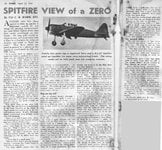The early P-36 and P-40 aircraft were totally lacking in both armour and self sealing tanks so they were no better than the A6M at that time. They were first fitted to P-36 and P-40 aircraft ordered for Britain and France. I suspect the first P-38s and 39s may have also lacked those items although the British and French demands and experience were starting to penetrate the US design philosophies by the time Pearl Harbor happened.
The British Tomahawks had fairly light seat armour which was heavier on the D/E aircraft and heavier again as the models progressed. Likewise their frontal protection grew with each model except that they removed the coolant tank armour on the D and subsequent aircraft.
As for the P-66 looking like an A6M all I can say is that you must think the Hurricane looks like the Mustang.
The early Spitfires Hurricanes and 109's didn't have armor either but they absolutely did once the shooting started and long before the A6M entered the war.

